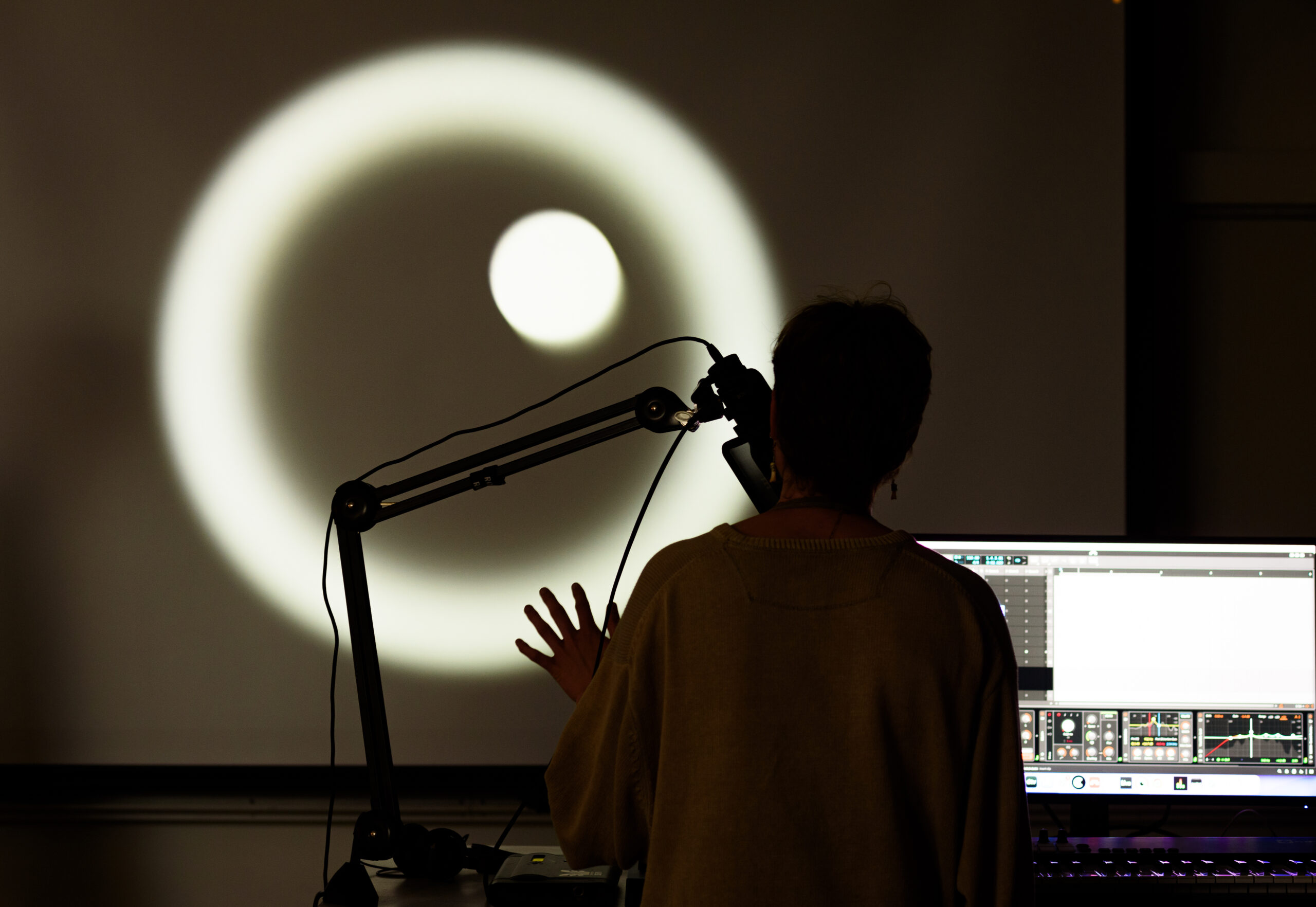
Last spring, students in Forrest Tobey’s advanced electronic music class invited the campus community to create sound installations using only movements from their hands, arms and mouths. The interactive demonstration was among the highlights of the Epic Expo, an all-campus celebration of scholarship and creativity.
Participants manipulated sound in real time and watched on a computer screen as their gestures created reverb and distortion using an array of electronic instruments, including hand-held controllers, drum pad, microphone and keyboard, which also changed the graphic images on the screen in real time.
“We work with music technology in the classroom more than a lot of people realize,” says Tobey, professor of music and director of Earlham Symphony Orchestra.
“My emphasis is on using computer software as a tool for music composition, sound design and live performance. We also have an increasing emphasis on using physical, old-school hardware synthesizers for a more organic and hands-on experience of electronic sound.”
Electronic music has been a fixture of Earlham’s curriculum since Tobey’s arrival on campus in 2003, and is a popular pathway for students to learn about music composition and emerging technologies.
“For many, the exhibit brought out their musical sides,” says Dove Rice-Snow ’26. “Social science professors sang with confidence into our system’s microphone, intrigued by the reverb and flanging that made their vocal shimmer and echo back to them. STEM students created beats, snapping, clapping, and using our drum pad as they watched the visual interface turn colors to their rhythms. I overheard a career center staff member explaining to a friend that this is how they make music nowadays.”
Tobey witnessed these experiences firsthand.
“They are learning to organize musical form and getting a better understanding of what constitutes music by experimenting with sound,” Tobey says. “The difference between composing for a string quartet, say, and composing for electronics is that you’re learning about the physics of sound and how to appreciate sound at a fundamental level. Students learn about processes that are foundational in electronics — filters, oscillators, resonance, amplitude envelopes, ring and frequency modulation, and so on — but applying them to musical creation.”
Tobey discovered a passion for performing electronic music in the 1990s while studying at the Peabody Conservatory of Music at Johns Hopkins University, where he earned a doctorate in musical arts in orchestral conducting and a master’s degree in electronic music performance.
“Peabody was an unusual conservatory in that era because they had an electronic music studio tucked up on the top floor of the main building,” he says. “I grew up in the era of progressive rock bands who popularized the use of synthesizers, and when I saw the opportunity to study computer music alongside orchestral conducting, I took full advantage of it. My doctoral dissertation was about training a computer to follow a conductor’s gestures. And now here I am, conducting Earlham’s orchestra and teaching electronic music.”
One of the instruments Tobey encountered at Peabody was the Buchla Lightning, a device that uses infrared wands to generate electronic sounds based on movement. He credits it for leading him to one of his big breaks: He was performing on it during a Peabody event that was attended by Michael Bloomberg, a Johns Hopkins alum and philanthropist who would go on to become a three-term mayor of New York City. The chance encounter was a catalyst for a once-in-a-lifetime opportunity to perform at Times Square in New York City as part of the Millennium Celebration that ushered in the year 2000.
His experiences with electronic music might have been a spark for what has become a long career at Earlham, too.
“I sometimes joke that I feel lucky to be at Earlham because I’m not sure anybody else would have hired someone who is as crazily eclectic as I am,” Tobey says.
Long before beicoming an electronic musician, Tobey was a freelance pianist and a public-school teacher in the Seattle area. He also taught at the Woodstock School in the foothills of the Himalayan Mountains in India while serving as the director of the Delhi Symphony for three years. He plays folk and jazz, and released two recordings this year: one featuring his solo piano improvisations, and another under the band name Off Chants, with his wife Lynnell Lewis, of songs and chants influenced by their time in India.
Tobey draws a particular distinction between the electronic music he teaches in class with other forms of popular computer-generated art forms, including techno.
“I have great respect for the people who perform techno music, but I can’t listen to it for very long,” Tobey says. “I think it’s because the computer is in charge of the beat. My interest in this work always has been to have electronic music stand in relationship to human gesture, which is another way of saying human emotion. When the music is connecting to gesture, it connects also to breath and therefore to spirit. There is a great quote by the composer George Crumb. He said, ‘Music is a system of proportions in service to a spiritual impulse.’ That pretty much sums it up for me, and I hope that I can bring that sensibility to my work with the students.”